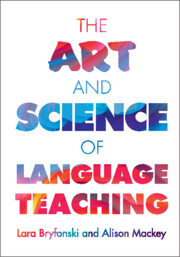Book contents
- The Art and Science of Language Teaching
- Reviews
- The Art and Science of Language Teaching
- Copyright page
- Dedication
- Contents
- Preface
- Acknowledgments
- Note on Terminology
- Pre-Reading Self-Assessment
- Part I Teacher and Student Talk
- Part II Differentiation
- Part III Teaching the Skills
- Part IV Lesson and Unit Planning
- 16 What are some of the most popular language teaching methods?
- 17 Content, form, and activities: How do I select activities, tasks, and projects?
- 18 Menus and maps: How can I make my classroom more authentic in terms of materials and practices?
- 19 How could/should I best use technology in the language classroom?
- 20 How do I assess language learning?
- 21 How can I make the most of professional development opportunities for language teachers?
- Glossary
- References and Resources
- Index
- References
20 - How do I assess language learning?
from Part IV - Lesson and Unit Planning
Published online by Cambridge University Press: 21 December 2023
- The Art and Science of Language Teaching
- Reviews
- The Art and Science of Language Teaching
- Copyright page
- Dedication
- Contents
- Preface
- Acknowledgments
- Note on Terminology
- Pre-Reading Self-Assessment
- Part I Teacher and Student Talk
- Part II Differentiation
- Part III Teaching the Skills
- Part IV Lesson and Unit Planning
- 16 What are some of the most popular language teaching methods?
- 17 Content, form, and activities: How do I select activities, tasks, and projects?
- 18 Menus and maps: How can I make my classroom more authentic in terms of materials and practices?
- 19 How could/should I best use technology in the language classroom?
- 20 How do I assess language learning?
- 21 How can I make the most of professional development opportunities for language teachers?
- Glossary
- References and Resources
- Index
- References
Summary
Chapter 20 offers insight on the qualities of assessments that are best able to support learners’ linguistic progress. The four principles of assessment are presented to equip teachers with the knowledge they need to select, adjust, and design assessments for their unique learning contexts. Alternative assessments, like e-portfolios, are also discussed as ways in which teachers can improve learners’ attitudes toward the target language.
Information
- Type
- Chapter
- Information
- The Art and Science of Language Teaching , pp. 297 - 317Publisher: Cambridge University PressPrint publication year: 2023
References
 Butler, Y. G., & Lee, J. (2010). The effects of self-assessment among young learners of English. Language Teaching, 27(1), 5–31. https://doi.org/10.1177/0265532209346370.Google Scholar
Butler, Y. G., & Lee, J. (2010). The effects of self-assessment among young learners of English. Language Teaching, 27(1), 5–31. https://doi.org/10.1177/0265532209346370.Google Scholar